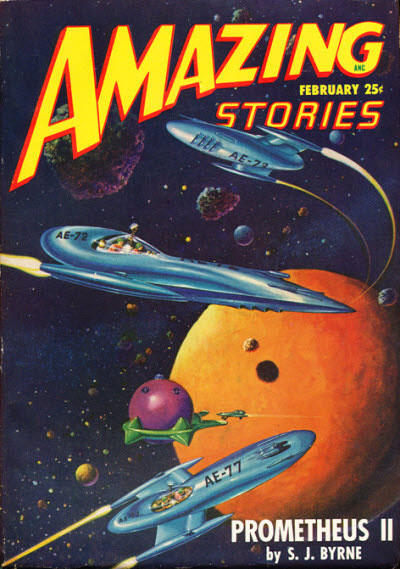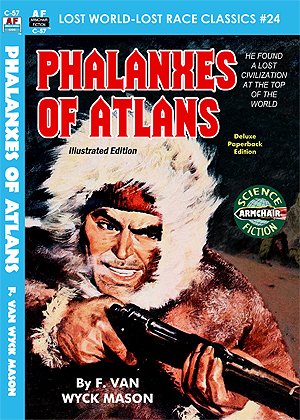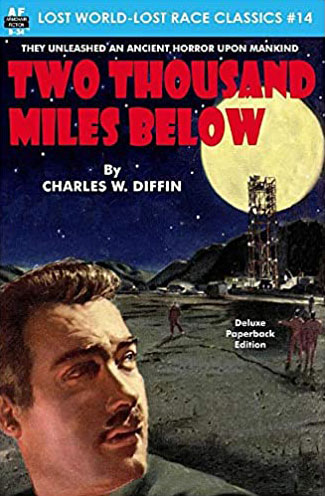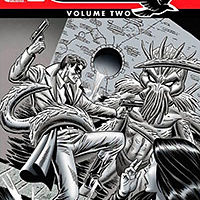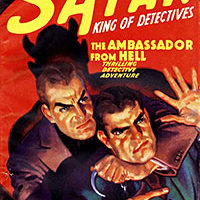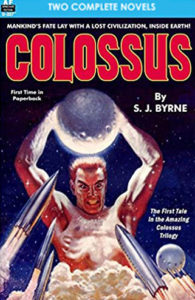 Stuart J. Byrne (1913-2011) is an overlooked pulp SF author that I’ve posted on previously. Thanks to Sinister Cinema‘s Armchair Theater line of books, several of his works have been reprinted.
Stuart J. Byrne (1913-2011) is an overlooked pulp SF author that I’ve posted on previously. Thanks to Sinister Cinema‘s Armchair Theater line of books, several of his works have been reprinted.
In a previous posting, I spoke of his Stephen Germain stories, Prometheus II (Amazing Stories, 1948) and The Golden Guardsman (Other Worlds, 1952). These works are also interesting because of the elements from the Shaver Mystery.
But I had read hints of another work that was tied to these, and finally Armchair Theater came through.
This is the “Colossus Trilogy,” originally a single novel written as a sequel to Prometheus II, but broken up into three parts and appearing in Other Worlds in 1950 as “Colossus,” “Colossus II,” and “Colossus III.” Breaking with tradition, only the third part was cover featured. And strangely, this sequel didn’t star Germain, but Steve “Rocky” Rockner and other characters, though Germain does appear.
The Armchair Theater put them out in D-227 as Colossus with Isle of Doom by Robert Moore Williams, and the second and third part of the Colossus Trilogy in D-246, as The Colossus Conclusion with The Mental Assassins by Rog Phillips, and uses that cover from Outer Worlds as the cover.
One thing I had read was that Ray Palmer, editor of Other Worlds, in addition to cutting it into three parts, removed the Shaver Mystery elements, though I’m not sure if so. I do wish that Armchair Theater had included all three parts in one volume.
We meet Rocky early on. An American adventurer, he had been prospecting in the mountainous areas of Asia, unaware of the events of Prometheus II, which tells of the attempts by Russia to take over the world. Learning of this, he makes his way to join up with the Western Democracies. This work is set in 1971, a year after the setting of Prometheus II. The menace of Russia was defeated by now, but he doesn’t know.
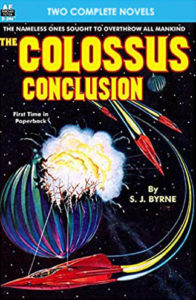 In Tibet, he runs into a strange tribe, and with them is a Westerner, Janice Maine, who seems a little mysterious. Rocky is given a special medallion, the “Sword of Agarthi.” Together Rocky and Janice head to the mountain that hides Agarthi, and through a bit of difficulty they enter. Rocky learns what is going on and wants to join up. But Janice is a different matter.
In Tibet, he runs into a strange tribe, and with them is a Westerner, Janice Maine, who seems a little mysterious. Rocky is given a special medallion, the “Sword of Agarthi.” Together Rocky and Janice head to the mountain that hides Agarthi, and through a bit of difficulty they enter. Rocky learns what is going on and wants to join up. But Janice is a different matter.
We learn that with the help of the Elder Gods in the last novel, the Russian Dictator Nicholas I was defeated along with the Deros. But we learn there is a new foe raising to stop Agarthi and the King of the World taking mankind to the next step. This new foe, based in Germany, is known only as “The Nameless Ones” and are the secret power behind all the kings, presidents, etc., of the world (but not Nicholas I?). And Janice’s father is the chairman of this group, though it appears he is not the true power behind things. There is an older and more sinister power behind The Nameless Ones.
Janice soon becomes an ally of Agarthi, and is a major protagonist in this story, along with others. Stephen Germain’s friend, Michael Kent from the first book, is recruiting veterans to the new Golden Guardsmen, which Rocky joins. The King of the World takes a more active role in this story, and they must confront the evil behind The Nameless Ones to save the world. They are aided by a new power, the Moon People, who are related to the Agarthis.
This story introduces several characters that will appear in The Golden Guardsmen, and some of the things I was confused by in the first part of that novel now make more sense after reading the three Colossus parts. Thus the Steve Germain series is properly a trilogy, with the Colossus works being the middle part, and should be read in that order to be most enjoyable.
As noted, Byrne has written several other works that have been reprinted by Armchair Fiction, which I hope to get to soon. So check out Armchair Fiction and their many excellent reprint works. They have put out a lot of good stuff and have sales on them as well.

